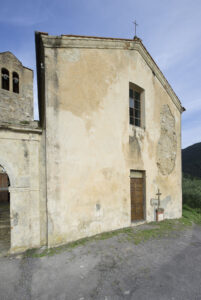Montemagno is a hamlet located about 200 meters above sea level in the southeastern part of Monte Pisano, within the municipality of Calci.
It has very ancient origins, as even its name attests. It derives from “Mons Janus,” a mountain dedicated to Janus, an ancient Roman deity. “Mons Janus” later transformed into “Monseianus,” corrupted into “Montemanius,” and eventually became “Montemagno.”
 The oldest document mentioning Montemagno is preserved in the State Archive of Pisa, dated April 30, 780. This document is a donation deed in which three Lombard-origin brothers offer their properties, including some located in Montemagno, for the construction of a monastery near the Church of San Savino in Ceragiolo (or Cerasiolo), Calci, along the Zambra stream. Between 1115 and 1122, a flood from the stream destroyed these buildings, which were then reconstructed in Montione di Cascina. The document also mentions the oldest church in Montemagno, the Church of San Martino. The Lombard brothers also ceded their properties around this church.
The oldest document mentioning Montemagno is preserved in the State Archive of Pisa, dated April 30, 780. This document is a donation deed in which three Lombard-origin brothers offer their properties, including some located in Montemagno, for the construction of a monastery near the Church of San Savino in Ceragiolo (or Cerasiolo), Calci, along the Zambra stream. Between 1115 and 1122, a flood from the stream destroyed these buildings, which were then reconstructed in Montione di Cascina. The document also mentions the oldest church in Montemagno, the Church of San Martino. The Lombard brothers also ceded their properties around this church.
The Church of San Martino, situated along the path leading to Monte Verruca, now also serves as the village cemetery. The current bell tower of the church was originally a tower strategically positioned to control the access route to Monte Verruca, where a fortress still stands.
 In 1025, the people of Montemagno built their own fortress, locally known as “Bonifacia,” derived from “bonum facere,” meaning to do well. This was the heraldic motto of the people of Montemagno during medieval times. In 1076, a church was built within the fortress so that the people could attend mass during times of danger. The church was dedicated to Santa Maria ad Nives (Madonna della Neve), to whom the Basilica of Santa Maria Maggiore in Rome is also dedicated. Over time, the Church of Madonna della Neve assumed the role of the parish church, and the Church of San Martino was abandoned. This shift led to the village’s development primarily around the Bonifacia fortress, at the expense of the San Martino area, which now only houses the village cemetery.
In 1025, the people of Montemagno built their own fortress, locally known as “Bonifacia,” derived from “bonum facere,” meaning to do well. This was the heraldic motto of the people of Montemagno during medieval times. In 1076, a church was built within the fortress so that the people could attend mass during times of danger. The church was dedicated to Santa Maria ad Nives (Madonna della Neve), to whom the Basilica of Santa Maria Maggiore in Rome is also dedicated. Over time, the Church of Madonna della Neve assumed the role of the parish church, and the Church of San Martino was abandoned. This shift led to the village’s development primarily around the Bonifacia fortress, at the expense of the San Martino area, which now only houses the village cemetery.
Once, the village was divided into three main neighborhoods: Villa Alta or Fortezza Bonifacia, Piè di Villa, and Venezia. The connecting area between Villa Alta and Piè di Villa developed later, and in 1770, the San Martino Bridge was constructed to connect Villa Alta to Venezia.
(Montemagno – Foto di Benedetto Gatti)

The village also extends along the stream Zambra of Montemagno, and the numerous oil mills and mills along its course attest to the stream’s significance as a source of wealth. The first waterwheel-powered mills were built after the year 1000 across the Calci valley. Exploiting this natural force expedited flour production times. Flour was obtained from grinding grains, especially wheat, and also from grinding chestnuts due to their abundance in the area. In a short span, the rural villages of the Calci valley transitioned from familial grinding to true industrial milling. Starting from the 1300s, the hydraulic wheel was also used for crushing olives, enhancing olive paste extraction and subsequently increasing oil production yields.
In the second half of the 1500s, Montemagno was a prosperous and active commune. Alongside Calci Pieve, Tre Colli, San Vito, Castelmaggiore, and Campo, it participated in the formation of the governing bodies of the Podesteria of Calci, with a consul and two councilors. The Podesteria of Calci, along with those of Vicopisano, Cascina, and Ripafratta, formed the Vicariato of Vicopisano, representing direct representation of the Grand Duke of Tuscany.
In 1573, Montemagno obtained the privilege from the Pieve of Calci to perform baptisms at the Church of Santa Maria ad Nives, with the condition of an annual payment of two pounds of white wax to the Pieve for the feast of Saint Ermolao.
The Florence State Archive holds 21 statutes of Montemagno dating from the early 1500s to 1718, which highlight the various activities in progress in the village.
Nel 1776 il Granduca Pietro Leopoldo I decretò la separazione di Montemagno da Calci, con il passaggio di Calci, Castelmaggiore e Tre Colli sotto il Comune di Pisa e di Montemagno, Nicosia e parte di Rezzano sotto il Comune di Vicopisano. Questo decreto creò, da un lato, un confine puramente amministrativo tra Pisa e Vicopisano
e, dall’altro, confermò e accrebbe il Comune di Vicopisano. Tale decreto restò in vigore fino al 1867, quando, dopo una lunga controversia, Buti riuscì a ottenere un’amministrazione autonoma da Vicopisano. Nel 1884, sull’altro versante del Monte Pisano, Calci ottenne l’autonomia da Pisa e in questo contesto fu segnato anche il passaggio di Montemagno da Vicopisano a Calci.
Once upon a time in Montemagno
